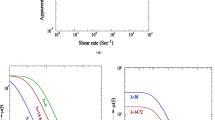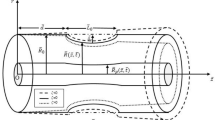Abstract
This article presents a numerical solution to the time-dependent blood flow in a ω-shaped stenosed vessel influenced by the body acceleration and pulsatile pressure gradient. The tangent hyperbolic fluid model is used to describe the blood rheology. The model under consideration is one of the non-Newtonian models whose constitutive equation is valid at both high and low shear rates. It falls into the class of generalized Newtonian fluids and is capable of describing the shear-thinning behaviour very well. It is proven that this model is significantly sensitive to modest changes in zero shear-rate viscosity and mildly sensitive to fluctuations in infinite shear-rate viscosity. As an accurate predictor of shear-thinning, this model is well suited for the rheology of blood. Scale analysis is used to simplify the basic equations of fluid flow and heat transport for the moderate constriction model. The effects of the vessel’s wall are immobilized via radial coordinate transformation. The resultant nonlinear system of differential equations with specified boundary conditions is computed by utilizing an explicit finite difference approach. The numerical analysis of the dominant quantities such as resistive impendence, flow rate, wall shear stress, axial velocity, and temperature field is performed with variations in the relevant non-dimensional parameters. These findings are represented graphically and described briefly in the discussion. The flow rate and blood velocity rise with escalating the amplitude of body acceleration; however, the reverse response is observed when the stenosis height, Weissenberg number, and power-law exponent are increased. In addition, the Brinkman number and Prandtl number are found to have significant effects on the temperature field.






















Similar content being viewed by others
Data availability statement
The data that supports the findings of this study are available within the article.
References
D.F. Young, Effect of time-dependent stenosis on flow through a tube. J. Eng. 90, 248–254 (1968)
J.H. Forrester, D.F. Young, Flow through a converging-diverging tube and its implications in occlusive vascular disease—I: theoretical development. J. Biomech. 3(3), 297–305 (1970)
J.H. Forrester, D.F. Young, Flow through a converging-diverging tube and its implications in occlusive vascular disease—II: theoretical and experimental results and their implications. J. Biomech. 3(3), 307–316 (1970)
J.S. Lee, Y.C. Fung, Flow in a locally constricted tube at low Reynolds number. J. Appl. Mech. 37(1), 9–16 (1970)
J.C.F. Chow, K. Soda, Laminar flow and blood oxygenation in channels with boundary irregularities. J. Appl. Mech. 40, 843–850 (1973)
B.E. Morgan, D.F. Young, An integral method for the analysis of flow in arterial stenosis. Bull. Math. Biol. 36, 39–53 (1974)
T. Azuma, T. Fukushima, Flow patterns in stenotic blood vessel models. Biorheology 13, 337–355 (1976)
D.A. MacDonald, On steady flow through modeled vascular stenosis. J. Biomech. 12, 13–30 (1979)
W. Youngchareon, D.F. Young, Initiation of turbulence in models of arterial stenosis. J. Biomech. 12, 185–196 (1979)
J. Doffin, F. Chagneau, Oscillating flow between a clot model and stenosis. J. Biomech. 14, 143–148 (1981)
J.C. Mishra, B.K. Sahu, Flow through blood vessels under the action of a periodic acceleration field: a mathematical analysis. Comput. Math. Appl. 16, 993–1016 (1988)
K. Perktold, R. Peter, M. Resch, Pulsatile non-Newtonian blood flow simulation through a bifurcation with an aneurism. Biorheology 26, 1011–1030 (1989)
C. Tu, M. Deville, Pulsatile flow of non-Newtonian fluids through arterial stenoses. J. Biomech. 29, 899–908 (1996)
R. Usha, K. Prema, Pulsatile flow of particle-fluid suspension model of blood under periodic body acceleration. ZAMP 50, 175–192 (1999)
M. El-Shahed, Pulsatile flow of blood through a stenosed porous medium under periodic body acceleration. Appl. Math. Comput. 138, 479–488 (2003)
P.K. Mandal, An unsteady of non-Newtonian blood flow through tapered arteries with stenosis. Int. J. Nonlinear Mech. 40, 151–164 (2005)
F. Yilmaz, M.Y. Gundogdu, A critical review on blood flow in large arteries; relevance to blood rheology, viscosity models, and physiologic conditions. J. Korea-Aust. Rheol. 20, 197–211 (2008)
Kh.S. Mekheimer, M.A.E.I. Kot, Mathematical modeling of unsteady flow of Sisko fluid through anisotropically tapered elastic arteries with time-variant overlapping stenosis. Appl. Math. Model. 36, 5393–5407 (2012)
D.S. Sankar, U. Lee, Mathematical modeling of the pulsatile flow of non-Newtonian fluid in stenosed arteries. Commun. Nonlinear Sci. Num. Simul. 14, 2971–2981 (2009)
N. Ali, A. Zaman, M. Sajid, J.J. Nieto, A. Torres, Unsteady non-Newtonian blood flow through a tapered overlapping stenosed catheterized vessel. Math. Biosci. 269, 94–103 (2015)
A. Zaman, N. Ali, M. Sajid, Slip effects on unsteady non-Newtonian blood flow through an inclined catheterized overlapping stenotic artery. AIP Adv. (2016). https://doi.org/10.1063/1.4941358
M. Roy, B.S. Sikarwar, M. Bhandwal, P. Ranjan, Modelling of blood flow in stenosed arteries. Procedia Comput. Sci. 115, 821–830 (2017)
S. Charm, G. Kurland, Viscometry of human blood for shear rates of 0–100,000 sec-1. Nature 206(4984), 617–618 (1965)
C.R. Huang, N. Siskovic, R.W. Robertson, W. Fabisiak, E.H. Smitherberg, A.L. Copley, Quantitative characterization of thixotropy of whole human blood. Biorheology 12(5), 279–282 (1975)
G.B. Thurston, Viscoelasticity of human blood. Biophys. J. 12(9), 1205–1217 (1972)
Gijsen, J.H. Frank, F.N. van de Vosse, J.D. Janssen, The influence of the non-Newtonian properties of blood on the flow in large arteries: steady flow in a carotid bifurcation model. J. Biomech. 32(6), 601–608 (1999)
F. Irgens, Rheology and Non-newtonian Fluids (Springer, New York, 2014), p. 190
J.V. Soulis, G.D. Giannoglou, Y.S. Chatzizisis, K.V. Seralidou, G.E. Parcharidis, G.E. Louridas, Non-Newtonian models for molecular viscosity and wall shear stress in a 3D reconstructed human left coronary artery. Med. Eng. Phys. 30(1), 9–19 (2008)
S. Karimi, M. Dabagh, P. Vasava, M. Dadvar, B. Dabir, P. Jalali, Effect of rheological models on the hemodynamics within human aorta: CFD study on CT image-based geometry. J. Nonnewton. Fluid Mech. 207, 42–52 (2014)
M. Iasiello, K. Vafai, A. Andreozzi, N. Bianco, Analysis of non-Newtonian effects within an aorta-iliac bifurcation region. J. Biomech. 64, 153–163 (2017)
A.B. Caballero, S. Lain, Numerical simulation of non-Newtonian blood flow dynamics in human thoracic aorta. Comput. Methods Biomech. Biomed. Eng. 18(11), 1200–1216 (2015)
J. Moradicheghamahi, J. Sadeghiseraji, M. Jahangiri, Numerical solution of the pulsatile: non-Newtonian and turbulent blood ow in a patient specific elastic carotid artery. Int. J. Mech. Sci. 150, 393–403 (2019)
S. O’Callaghan, M. Walsh, T. McGloughlin, Numerical modelling of Newtonian and non-Newtonian representation of blood in a distal end-to-side vascular bypass graft anastomosis. Med. Eng. Phys. 28(1), 70–74 (2006)
M. Abbasian, M. Shams, Z. Valizadeh, A. Moshfegh, A. Javadzadegan, S. Cheng, Effects of different non-Newtonian models on unsteady blood flow hemodynamics in patient-specific arterial models with in-vivo validation. Comput. Methods Programs Biomed. 186, 105185 (2020)
I. Pop, D.B. Ingham, Convective Heat Transfer: Mathematical and Computational Modelling of Viscous Fluids and Porous Media (Pergamon, Amsterdam, NewYork, 2001)
S. Nadeem, S. Akram, Peristaltic transport of a hyperbolic tangent fluid model in an asymmetric channel. ZNA 64a, 559–567 (2009)
S. Nadeem, S. Ijaz, Theoretical analysis of shear thinning hyperbolic tangent fluid model for blood flow in curved artery with stenosis. J. Appl. Fluid Mech. 9(5), 2217–2227 (2016)
S. Jyothi, M.S. Reddy, P. Gangavathi, Hyperbolic tangent fluid flow through a porous medium in an inclined channel with peristalsis. Int. J. Adv. Sci. Res. Manag. 1(4), 113–121 (2016)
M. Naseer, M.Y. Malik, S. Nadeem, A. Rehman, The boundary layer flow of hyperbolic tangent fluid over a vertical exponentially stretching cylinder. Alex. Eng. J. 53, 747–750 (2014)
S. Nadeem, H. Sadaf, N.S. Akbar, Effects of nanoparticles on the peristaltic motion of tangent hyperbolic fluid model in an annulus. Alex. Eng. J. 54(4), 843–851 (2015)
M.A. Abbas, Y.Q. Bai, M.M. Bhatti, M.M. Rashidi, Three-dimensional peristaltic flow of hyperbolic tangent fluid in a non-uniform channel having flexible walls. Alex. Eng. J. 55(1), 653–662 (2016)
T. Hayat, T. Abbas, M. Ayub, M. Farooq, A. Alsaedi, Flow of nanofluid due to convectively heated Riga plate with variable thickness. J. Mol. Liq. 222, 854–862 (2016)
S. Charm, B. Paltiel, G.S. Kurland, Heat transfer coefficients in blood flow. Biorheology 5(2), 133–145 (1968)
J.C. Chato, Heat transfer to blood vessels. J. Biomech. Eng. 102(2), 110–118 (1980)
M.C. Kolios, M.D. Sherar, J.W. Hunt, Large blood vessel cooling in heated tissues: a numerical study. Phys. Med. Biol. 40, 477–494 (1995)
A. Ogulu, M.A. Tamunoimi, Simulation of heat transfer on an oscillatory blood flow in an indented porous artery. Int. Commun. Heat Mass Transf. 32(7), 983–989 (2005)
A.E. Garcia, D.N. Riahi, Two-phase blood flow and heat transfer in an inclined stenosed artery with or without a catheter. Int. J. Fluid Mech. Res. 41(1), 16–30 (2014)
A. Zaman, N. Ali, O.A. Bég, Heat and mass transfer to blood through a tapered overlapping stenosed artery. Int. J. Heat Mass Transf. 95, 1084–1095 (2016)
M.S.A. Jamali, Z. Ismail, Simulation of heat transfer on blood flow through a stenosed bifurcated artery. J. Adv. Res. Fluid Mech. Therm. Sci. 60(2), 310–323 (2019)
Y. Liu, W. Liu, Blood flow analysis in tapered stenosed arteries with the influence of heat and mass transfer. J. Appl. Math. Comput. 63(1), 523–541 (2020)
M. Fahim, M. Sajid, N. Ali, Non-isothermal flow of Sisko fluid in a stenotic tube induced via pulsatile pressure gradient and periodic body acceleration. Phys. Scr. 96(8), 085211 (2021)
M. Thiriet, Biology and Mechanics of Blood Flows: Part II: Mechanics and Medical Aspects (Springer, Berlin, 2007)
F. Yilmaz, M.Y. Gundogdu, A critical review on blood flow in large arteries; relevance to blood rheology, viscosity models, and physiologic conditions. Korea-Austr. Rheol. J. 20(4), 197–211 (2008)
P.K. Kundu, I.M. Cohen, D.R. Dowling, Fluid Mechanics (Academic Press, Cambridge, 2015)
C. Vlachopoulos, M. O’Rourke, W.W. Nichols, McDonald’s Blood Flow in Arteries: Theoretical, Experimental and Clinical Principles (CRC Press, Cambridge, 2011)
G.S. Malindzak, Fourier analysis of cardiovascular events. Math. Biosci. 7(3), 273–289 (1970)
J. Alastruey, K. H. Parker, and S. J. Sherwin, Arterial pulse wave haemodynamics. in 11th international conference on pressure surges. Virtual PiE Led t/a BHR Group, (2012) 401–443.
Acknowledgements
The valuable feedback from the reviewers and editor is highly appreciated. The authors would like to express their gratitude to HEC Pakistan for the financial assistance granted under Project No: 5785/ Federal/NRPU/ R&D/HEC/2017.
Author information
Authors and Affiliations
Corresponding author
Rights and permissions
About this article
Cite this article
Fahim, M., Sajid, M., Ali, N. et al. Unsteady nonisothermal tangent hyperbolic fluid flow in a stenosed blood vessel with pulsatile pressure gradient and body acceleration. Eur. Phys. J. Plus 137, 847 (2022). https://doi.org/10.1140/epjp/s13360-022-03035-5
Received:
Accepted:
Published:
DOI: https://doi.org/10.1140/epjp/s13360-022-03035-5




